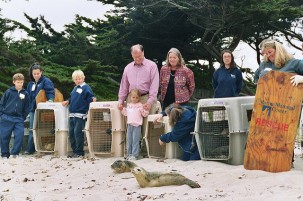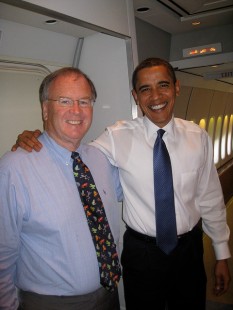
As a kid in the 1940s, Sam Farr used to frequent the tide pools on Carmel Beach, exploring and playing with the multitude of colorful creatures that lived there. But when he returned as an adult with his young daughter in tow, the tide pools weren’t quite how he remembered them.
“Not a single animal was there,” he recalls. “Not a sea urchin, not a sea anemone, not a hermit crab.”
The experience added to Farr’s already deep-seated belief that ocean health is crucial to the well-being of our planet and ourselves. First as a California State Assemblyman from 1980-1993, and then as a U.S. Congressman from 1993 to the present, he acted on that belief by creating state and federal legislation to protect our ocean and coast, and to support ocean research along Monterey Bay.
Now, after more than 40 years of public service, Farr is returning from Washington, D.C. to his home in Carmel, California to, in his words, “become a full-time grandfather” to his daughter Jessica’s children, Ella and Zachary.
On Dec. 1, 2016, Monterey Bay Aquarium honored Sam Farr’s lifelong contributions to ocean conservation at a reception for community leaders and philanthropists.

Spotlight on the ocean
The ocean inspires us with its vastness, its seemingly endless horizons and mind-boggling depths. But we’ve learned that it is not infinite. There are limits to how much seafood it can provide before fish stocks collapse; to how much pollution it can tolerate before its ecosystems become unhealthy.
Farr understood this ahead of his peers, and he invited then-President Bill Clinton to Monterey for the first-ever National Ocean Conference in 1998. The meeting, attended by powerful officials including U.S. President Bill Clinton, Vice President Al Gore, First Lady Hillary Clinton and California Senator Barbara Boxer, served as a catalyst for major federal action.
Using the conference as grist, Farr championed the U.S. Oceans Act of 2000, which created a 16-member U.S. Commission on Ocean Policy to re-evaluate the management of ocean resources. The commission’s recommendations were packaged into Farr’s Oceans Conservation, Education and National Strategy for the 21st Century Act, also known as “Oceans-21.” Although this bill met with resistance in Congress, many of its provisions were later incorporated into President Barack Obama’s National Ocean Policy—a milestone for ocean health.
“There are only three times the federal government has created a national policy for the environment,” Farr says. “First there was the Clean Water Act, and then the Clean Air Act. This policy is the third leg.”
The policy aims to improve our ability to forecast ocean conditions (including sea-level rise), support ocean-based industries and restore and protect important ocean habitats.

A tidal wave of change
Sam Farr has catalyzed numerous other policies benefiting ocean health. During his time as a California assemblyman, he combatted the dangers of ocean pollution by authoring the Coastal Clean-Up law that grew into an annual, international event. As a U.S. Congressman, he authored successful legislation to strengthen NOAA’s Marine Debris Program, which protects our coast from hazardous debris and pollution.
Shortly after his election to Congress, Farr formed the bipartisan House Oceans Caucus to educate officials about the issues facing our world’s oceans. He’s hosted countless briefings, discussions, and events to educate and support ocean conservation.
As a member of the House Appropriations Committee, which oversees the distribution of the federal budget, Farr has secured $100 million in funding for marine research to fight ocean acidification and marine debris, support habitat restoration and protect sea otters. His position on the committee enabled him to secure funding for a new federal marine laboratory in Santa Cruz.
One of the accomplishments Farr is most proud of is his legislative efforts that led the Clinton administration to designate the California Coastal National Monument, which protects the offshore rocks and islands along the entire California coast. Another point of pride is his Federal Ocean Acidification Research and Monitoring Act, which aims to mitigate the effects of global warming and ocean acidification on fisheries and aquaculture. He has been a consistent champion for marine protected areas and a steady advocate for National Oceanic and Atmospheric Administration (NOAA) funding and programs.

Making the ocean connection
Today, thanks to decades of protective policy and public support, the Carmel Beach tide pools that enthralled Farr as a child are once again thriving with sea life.
Congressman Farr believes that education and outreach are key to a healthy ocean. But some people have never visited the sea, much less experienced it from below the surface. That’s why Farr is proud to have supported and worked with organizations like the Monterey Bay Aquarium, which inspires the public to observe, touch and interact with the sea.
“You might call me an ocean leader, but I can’t lead if people won’t follow. And people won’t follow unless they’re educated,” he says. “People have to understand that our oceans are as important to our survival as air or water.”
Farr knows from personal experience that early exposure to the ocean can inspire a lifetime of meaningful action. That connection—forged in nature and schools, in aquariums and museums—represents hope for a blue future.

Reblogged this on Diana LaScala-Gruenewald.
LikeLike